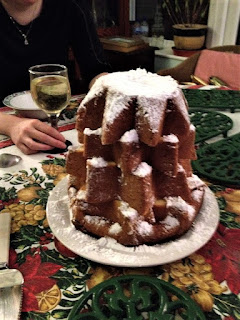Which can claim the oldest Christmas tradition?
The festive treats tucked into by Italian families on Christmas Day almost always include a wedge or slice of panettone, the fluffy sweet bread with the familiar dome shape that sells in tens of millions at this time of year.
Panettone is served as a Christmas treat by families
not just in Italy but all over the world
In little more than 100 years since it was first produced commercially on a large scale, panettone has gained such popularity that it has become readily available in food outlets on almost every continent.
It is rare to find a supermarket in the United Kingdom, Canada and the United States, or in most western European countries, which does not have panettone jostling for shelf space with indigenous Christmas specialities.
Nowadays, panettone is finding increasing competition from another Italian sweet bread frequently seen on Christmas tables, its tall star-shaped rival, pandoro.
A recent Twitter poll conducted by the website thelocal.it found that panettone was still the preferred choice of about two thirds of participants, but pandoro’s popularity is almost certainly on the rise.
 |
| Bauli is one of the oldest brands of the classic panettone bread |
One story in Italian folklore claims that panettone was served at a lavish, 12-course Christmas Eve banquet thrown in the late 15th century by Ludovico il Moro, Duke of Milan, but only after the dessert made by the Duke’s head pastry chef, had accidentally been burned.
A young kitchen assistant called Toni is said to have saved the day by adding raisins and orange peel to some dough left over from the original dessert to fashion an impromptu cake. The Duke and his guests are said to have enjoyed the cake so much they asked the pastry chef what it was called, to which he replied ‘Pane di Toni’ - Tony’s bread.
There is no way of knowing whether that story is authentic. The earliest actual record of a sweet bread resembling panettone is that which appeared in a register of expenses of the Borromeo college of Pavia in 1599.
The entry for December 23 of that year includes the costs for five pounds of butter, two pounds of raisins and three ounces of spices for the baker to make 13 loaves to be given to college students on Christmas Day.
Large scale manufacture of panettone began in Milan in the early part of the 20th century. Baker Angelo Motta was the first to set up a production facility for the bread, creating its characteristic dome shape by making the dough rise three times in a 20-hour period.
Pandoro is similarly thought to date back to the 15th century, when Venetian bakers are said to have dusted cone-shaped loaves with real gold for their wealthy clients, hence the name pan d’oro - bread of gold - although others believe the name derives from the golden colour obtained by adding egg to the dough.
Pandoro is often sliced and dusted with
icing sugar for the Christmas table
The pandoro made today, though, originates in Verona and is thought to have evolved from a traditional Veronese Christmas cake called nadalin, invented in the 13th century to celebrate the first Christmas in the city under the rule of the Scala family.
Nadalin was a flat cake with a crust of granulated sugar, marsala wine, almonds and pine nuts, but its star shape, said to represent the comet that guided the Magi to Bethlehem, is thought to have been the inspiration for the shape of pandoro.
Industrial-scale production of pandoro began in Verona 1894 in a factory begun by entrepreneur Domenico Melegatti.
Both panettone and pandoro are sold today as Christmas specialities. Pandoro generally comes with icing sugar to sprinkle over the cone before serving. A popular way to serve pandoro is to slice the bread horizontally and arrange the star-shaped slices so that they resemble the shape of a Christmas tree.
Travel tip:.jpg)
The Roman amphitheatre in Verona is one of
the city'a many tourist attractions
Verona, the traditional home of pandoro, is the third largest city in northeast Italy, with a population across its whole urban area of more than 700,000. It has a wealth of tourist attractions, of which the Roman amphitheatre known the world over as L’Arena di Verona is just one. The city was also the setting for three plays by Shakespeare – Romeo and Juliet, The Two Gentlemen of Verona and The Taming of the Shrew - although it is unknown whether the English playwright ever actually set foot in the city. Nonetheless, tourists flock to visit a 13th century house in Verona where Juliet is said to have lived, even though there is no evidence that Juliet and Romeo actually existed and the balcony said to have inspired Shakespeare’s imagination was not added until the early 20th century.
Travel tip:
The beautiful Piazza Ducale in Vigevano, as
seen from the Castello Sforzesco
The banquet thrown by Ludovico il Moro, who was a member of the Sforza family, quite likely took place at the Castello Sforzesco in Vigevano, a Lombard fortress developed by the Visconti family and rebuilt between 1492–94 for Ludovico, who transformed the fortification into a rich noble residence. Leonardo da Vinci was often his guest at Vigevano, as was the architect Donato Bramante, who designed the tower that watches over the beautiful rectangular Piazza Ducale, which was completed in 1493 as the forecourt to the castle. The Peroni Brewery was founded by Giovanni Peroni in Vigevano in 1846.
Also on this day:
800: Charlemagne, King of the Franks and the Lombards, crowned Holy Roman Emperor
1874: The birth of soprano Lina Cavalieri
1988: The birth of singer-songwriter Marco Mengoni
No comments:
Post a Comment